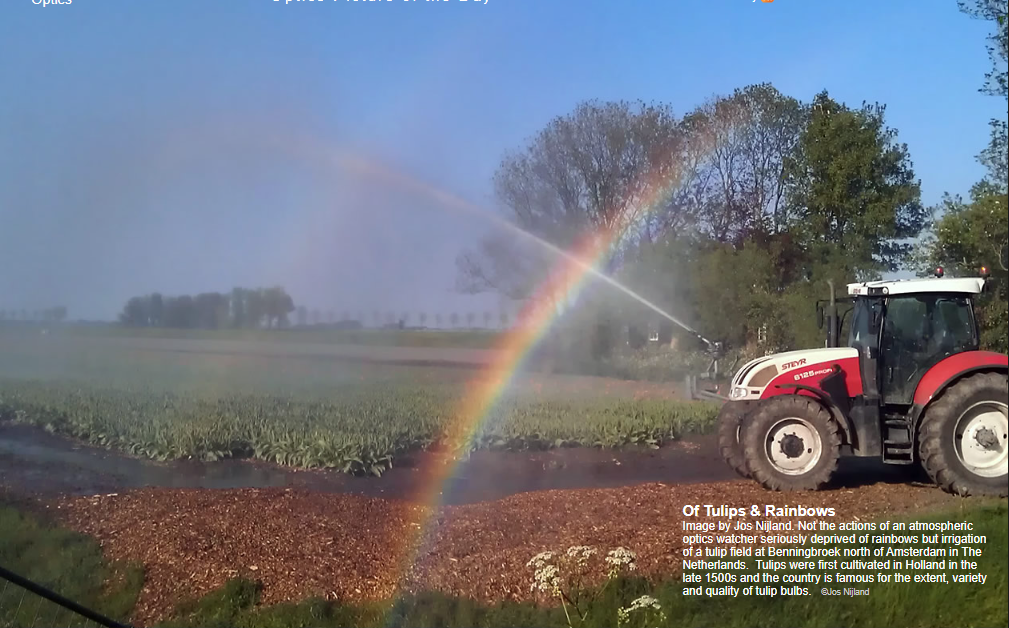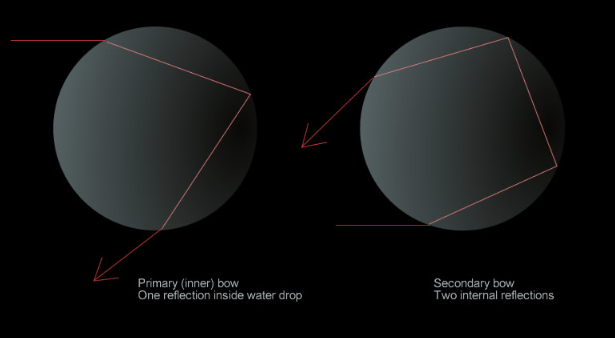OPOD - Of Tulips & Rainbows
OPOD - Of Tulips & Rainbows: A Colorful Intersection of Nature and Culture
Welcome to a captivating world where the vibrant hues of tulips blend harmoniously with the ethereal beauty of rainbows. In this blog post, we will explore the enchanting connection between these two awe-inspiring phenomena. While tulips have long been associated with the Netherlands, their cultivation and the country's rich history with tulip bulbs, we will delve deeper into the captivating optical effects that can occur when these beautiful flowers are irrigated. So, let's embark on a journey that combines the wonders of nature and the marvels of atmospheric optics.
The Luminous Symphony of Irrigated Tulip Fields
Imagine a scene where a field of tulips is being irrigated. As water droplets delicately fall upon the petals, a spectacle unfolds before our eyes. The interplay between sunlight and water droplets gives rise to a myriad of optical phenomena that captivate and inspire. The glistening droplets act as tiny prisms, refracting sunlight and dispersing it into its component colors. This phenomenon, known as dispersion, forms the foundation for the formation of rainbows and other fascinating atmospheric optical effects.
The Dance of Light and Color
When sunlight encounters water droplets in the air, it undergoes a series of intricate interactions that result in the creation of rainbows. As the sunlight enters the droplet, it bends or refracts, and then reflects off the inner surface before exiting the droplet. This bending and reflection cause the light to disperse into its constituent colors, forming a circular band of vibrant hues. The primary rainbow appears as a semicircle with red on the outer edge and violet on the inner edge. Occasionally, a secondary rainbow may also appear, characterized by a reversal of color order and a wider separation between its arcs.
Beyond Rainbows: Exploring Additional Atmospheric Optical Delights
While rainbows steal the spotlight in the realm of atmospheric optics, they are not the only phenomena that can grace our skies. Let's explore some other captivating optical effects that can occur when tulip fields are irrigated:
-
Supernumerary Rainbows: These delicate, pastel-colored arcs sometimes appear on the inner edge of the primary rainbow. They arise due to interference between light waves as they undergo multiple internal reflections within the water droplets.
-
Tulip Field Coronas: When sunlight interacts with tiny water droplets or ice crystals suspended in the air, it can produce captivating circular rings of colors surrounding the sun. These phenomena, known as coronas, can occasionally be observed above tulip fields, adding an enchanting touch to the already breathtaking scenery.
-
Glories: Picture a field of tulips stretching as far as the eye can see, with a mist or fog hanging in the air. If you were to look down from above, you might be fortunate enough to witness a glory. This phenomenon appears as a series of concentric rings of colors centered around your shadow. It is caused by the diffraction of light as it interacts with tiny water droplets or small particles in the atmosphere.
-
Tulip Field Fogbows: As fog drifts across a tulip field, an elusive and ethereal sight may grace the landscape. Fogbows, also known as white rainbows or cloudbows, are similar to rainbows but appear as pale arcs with significantly less color intensity. They occur when sunlight interacts with water droplets in fog, producing a diffraction pattern that creates the illusion of a bow.
The Beauty of Nature and the Artistry of Humans
The mesmerizing beauty of tulip fields, enhanced by the interplay of light and water, has not gone unnoticed by humans. For centuries, artists have sought to capture the essence of these enchanting scenes on canvas. Paintings depicting tulip fields bathed in the radiance of rainbows or drenched in the ethereal glow of misty coronas serve as testaments to the enduring fascination with these captivating optical phenomena.
A Tapestry of Culture and Science
The intersection of tulips and rainbows is not merely a meeting of nature and art but also a tapestry woven with cultural significance and scientific exploration. The Netherlands, renowned for its tulip cultivation, has embraced these vibrant flowers as an emblem of its national identity. Tulip festivals and events celebrate the rich history and cultural heritage associated with these beloved blooms.
From a scientific perspective, the study of atmospheric optics provides invaluable insights into the behavior of light and the complexities of our atmosphere. By unraveling the mysteries behind the formation of rainbows and other optical phenomena, researchers deepen our understanding of the fundamental principles governing our world.
Conclusion: A Kaleidoscope of Wonder
As we conclude our exploration of the captivating intersection between tulips and rainbows, we are left in awe of the wonders that nature and science bestow upon us. The vibrant tapestry of colors painted across tulip fields, complemented by the optical delights that dance through the sky, reminds us of the extraordinary beauty that surrounds us. So, the next time you find yourself in the presence of a tulip field or witness the enchanting allure of a rainbow, take a moment to appreciate the intricate symphony of light, water, and human ingenuity that converges to create these breathtaking spectacles.

Of Tulips & Rainbows
Image by Jos Nijland. Not the actions of an atmospheric optics watcher seriously deprived of rainbows but irrigation of a tulip field at Benningbroek north of Amsterdam in The Netherlands. Tulips were first cultivated in Holland in the late 1500s and the country is famous for the extent, variety and quality of tulip bulbs. ©Jos Nijland

Note: this article has been automatically converted from the old site and may not appear as intended. You can find the original article here.
Reference Atmospheric Optics
If you use any of the definitions, information, or data presented on Atmospheric Optics, please copy the link or reference below to properly credit us as the reference source. Thank you!
-
<a href="https://atoptics.co.uk/blog/opod-of-tulips-rainbows/">OPOD - Of Tulips & Rainbows</a>
-
"OPOD - Of Tulips & Rainbows". Atmospheric Optics. Accessed on April 24, 2024. https://atoptics.co.uk/blog/opod-of-tulips-rainbows/.
-
"OPOD - Of Tulips & Rainbows". Atmospheric Optics, https://atoptics.co.uk/blog/opod-of-tulips-rainbows/. Accessed 24 April, 2024
-
OPOD - Of Tulips & Rainbows. Atmospheric Optics. Retrieved from https://atoptics.co.uk/blog/opod-of-tulips-rainbows/.